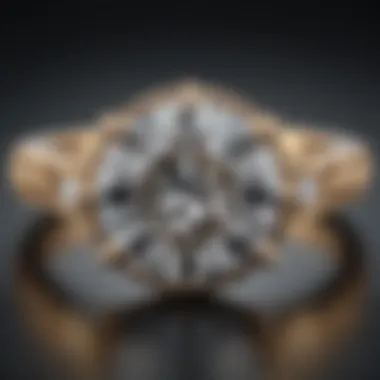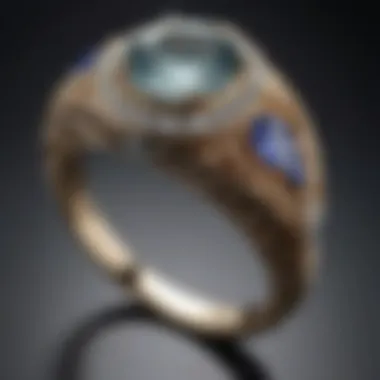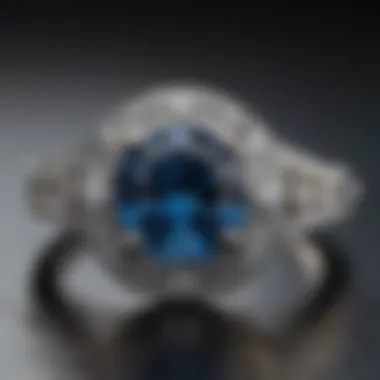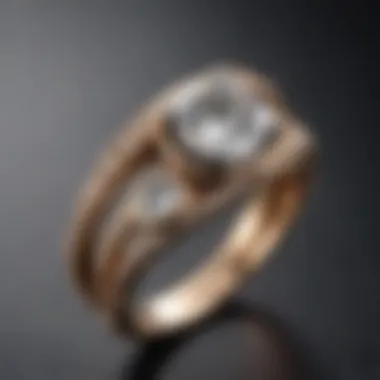Elegant Engagement Ring Settings: A Detailed Guide


Intro
In the world of engagement rings, the setting is a vital component that defines the ring's character and overall allure. High-end engagement ring settings not only enhance the beauty of the gemstone but also reflect the wearer's personal style. Understanding the various settings, materials, and techniques used in crafting these exquisite pieces can significantly influence one’s choice, ensuring that it aligns perfectly with individual tastes and preferences. This guide will provide an in-depth exploration of high-end engagement ring settings, tailored for gemstone enthusiasts, collectors, jewelry designers, and geology enthusiasts.
Gemstone Overview
Definition of Gemstones
Gemstones are naturally occurring minerals or crystals that are prized for their beauty and rarity. They are often cut and polished to create stunning pieces of jewelry. While many gemstones are well-known, such as diamonds, emeralds, and sapphires, there is a vast array of lesser-known varieties that can also be striking additions to engagement rings.
Classification of Gemstones
Gemstones can be classified into two primary categories: precious and semi-precious. Precious gemstones include diamonds, rubies, sapphires, and emeralds, revered for their quality and value. Semi-precious stones comprise a broader range, such as amethyst, garnet, and aquamarine, which, while beautiful, typically do not command the same market prices. This classification impacts not only the value but also the desirability of certain settings when paired with specific gemstones.
"The choice of gemstone significantly influences the engagement ring's overall aesthetic and can reflect the wearer's unique personality."
Historical Significance
Origins of Gemstone Use
The use of gemstones dates back thousands of years. Ancient civilizations utilized these natural wonders for various purposes, from adornment to religious ceremonies. The symbolic value attached to different stones has evolved over time, making certain gemstones significant in engagement rings today.
Cultural Insights: Gemstones in Ancient Civilizations
In ancient Egypt, turquoise was valued as a protective stone, while ancient Romans believed that sapphires brought peace. Understanding these historical associations can provide insight into the selection of gemstones and settings, revealing both aesthetic and sentimental significance. For instance, many contemporary engagement rings incorporate symbolism rooted in ancient lore, bridging personal sentiment with cultural history.
As we move through the article, we'll delve deeper into the styles and craftsmanship of high-end engagement ring settings, examine the latest trends in the industry, and provide tips to select the perfect setting to complement your chosen gemstone.
Understanding High-End Engagement Ring Settings
High-end engagement ring settings represent more than just a way to house a gemstone; they embody the artistry and craftsmanship that create a lasting symbol of love and commitment. This section serves as an essential foundation for the subsequent exploration of styles, materials, and trends. Understanding these settings allows individuals to appreciate not only their aesthetic appeal but also their significance in the context of personal expression and heritage.
Defining High-End Engagement Rings
High-end engagement rings are characterized by their exceptional quality, both in the gemstones selected and the settings that hold them. These rings often feature precious metals such as platinum or high-grade gold, and they incorporate designs that are meticulously crafted. The term "high-end" implies a level of craftsmanship that exceeds mass-produced alternatives, paying attention to detail and lasting beauty. When one refers to high-end engagement rings, it typically includes custom designs, unique settings, and gemstones with superior grading.
In defining what makes an engagement ring high-end, several factors stand out:
- Quality of Materials: The metals and gemstones must meet high standards. This includes selecting high-carat gold, platinum, or rare gemstones.
- Craftsmanship: Rings must exhibit high levels of skill, showing precision in the setting and overall design.
- Customization: Many high-end pieces are bespoke, tailored to the individual's preferences rather than following generic templates.
Importance of Setting in Engagement Rings
The setting of an engagement ring plays a critical role in both aesthetic appeal and functionality. A well-chosen setting can enhance the visibility and beauty of the gemstone it houses. It impacts how light enters the stone, influencing its brilliance and sparkle. Furthermore, the setting contributes to the overall shape and design complexity of the ring.
Choosing the right setting also has practical implications. For example, a prong setting, which lifts the gemstone to allow maximum light exposure, is preferable for more brilliant stones like diamonds. In contrast, a bezel setting offers robust protection for softer stones. Here are some key points about the significance of the setting:
- Aesthetic Appeal: It frames and complements the gemstone, affecting the overall appearance.
- Durability: The setting can provide protection for the stone and ensure that it stays securely in place.
- Personalization: Different settings can reflect personal style preferences and values, making the ring more meaningful.
"A well-designed setting is not just a background; it is an integral part of the jewel that brings the gem to life."
In summary, understanding high-end engagement ring settings requires appreciation of craftsmanship, material quality, and the role each element plays in creating a timeless piece of jewelry.


Types of Engagement Ring Settings
Understanding the various types of engagement ring settings is essential for anyone interested in high-end jewelry. Each setting presents unique characteristics, and choosing the right one can significantly impact the ring's aesthetic and value. The setting acts as the framework that holds and displays the gemstone, influencing how it reflects light, the overall durability of the piece, and the way it complements the wearer's personal style. This comprehension is crucial for gemstone enthusiasts and collectors who seek to make informed choices.
Prong Settings
Prong settings are among the most popular choices for engagement rings. This design typically features three to six metal prongs that secure the gemstone in place. The prongs elevate the stone, allowing more light to enter from various angles, enhanced brilliance. One of the significant advantages of prong settings is flexibility in design. They can be crafted in various metals and can accommodate different stone shapes optimally. However, they may require regular maintenance since the prongs can bend or wear over time, potentially jeopardizing the security of the gemstone.
Bezel Settings
A bezel setting provides a sleek, modern appearance. In this configuration, the gemstone is fully encircled by a narrow band of metal. This ensures stability, as the stone is less likely to become loose than in prong settings. Bezel settings also offer a lower profile, making them comfortable for everyday wear. This style works well with both round and fancy-shaped stones and is especially favored by those who lead active lifestyles. Bezel settings can be challenging to resize, so it's vital to ensure the initial size is accurate.
Halo Settings
Halo settings feature a central gemstone surrounded by a circle of smaller diamonds or gemstones. This design creates an eye-catching effect, enhancing the size and brilliance of the center stone. The added stones add extra sparkle while often being a more cost-effective way to amplify the perceived size of the main gem. While halo settings are visually striking, they may demand extra care since smaller stones can come loose or require cleaning. This setting is an excellent choice for those who appreciate a vintage or luxurious flair.
Pavé Settings
Pavé settings involve embedding small gemstones directly into the band of the ring, creating a continuous sparkle. The stones are set closely together, often made to appear seamless. The main benefit of pavé settings is the enormous visual impact they create, which can make an engagement ring appear more elaborate. However, since the stones are smaller, they may not be as durable as larger ones and can be subject to wear. Routine maintenance is crucial to ensure the stones remain secure and clean.
Channel Settings
In channel settings, gemstones are set in a row between two metal walls. This design protects the stones and minimizes the risk of snagging on clothing. Channel settings deliver a smooth and sophisticated look, suitable for individuals who prefer understated elegance. They can be crafted with a variety of stone sizes and shapes but are typically best suited for round or square stones. The challenge lies in resizing, as the setting's structure can complicate adjustments.
These various types of engagement ring settings show the importance of selecting the right foundation for your ring. Each style serves distinct aesthetic purposes and practical considerations, appealing to various personal tastes and lifestyles. When choosing a setting, it is vital to consider not just the appearance but also how it fits into everyday life.
Materials Used in High-End Settings
Understanding the materials used in high-end engagement ring settings is essential. The choice of materials significantly influences both the aesthetic appeal and durability of a ring. Different metals and gemstones provide distinct benefits. The selected materials reflect personal style as well as practical considerations. The knowledge of materials and their characteristics can lead to informed decisions that resonate with a couple's preferences and lifestyle.
Metal Options
Gold
Gold is a classic choice for engagement rings. It is available in several colors including yellow, white, and rose. Gold's intrinsic value and malleability make it a favored metal among jewelry designers. A key characteristic of gold is its longevity. Many people appreciate that gold can withstand daily wear while still looking elegant. However, gold can be soft, especially in higher karat options, which might make it susceptible to scratches.
Platinum
Platinum is the epitome of luxury when it comes to engagement rings. This metal is immensely durable, making it an ideal choice for daily wear. Its resistance to tarnish and its hypoallergenic properties make platinum a practical and safe option for anyone. Additionally, its rarity contributes to its status and higher price point. However, it can be heavier than other metals, which may not suit everyone's preference.
White Gold
White gold is an alloy that combines gold with metals like palladium or nickel. This synthesis gives it a bright, silvery appearance. The rhodium plating applied to white gold enhances its shiny finish, covering the natural color beneath. This option is popular due to its similarity to platinum at a more attainable price. Over time, rhodium may wear off, requiring re-plating to restore its original luster.
Rose Gold
Rose gold has gained popularity thanks to its unique warmth. The blend of gold with copper provides a distinctive hue. This metal not only looks beautiful but also offers good durability. Rose gold is versatile, blending well with various gemstones. However, the copper content can cause allergic reactions in some people, which is a consideration for those sensitive to metals.
Craftsmanship in High-End Ring Settings
Craftsmanship is vital in the realm of high-end engagement ring settings. It encompasses the skills and techniques employed in creating each piece. This area of jewelry design not only influences aesthetics but also impacts the durability and value of the ring. A well-crafted ring can be a reflection of personal style and artisanal tradition. Investing in quality craftsmanship ensures that the ring can withstand daily wear while maintaining its beauty over time.
Precision and Detail


Precision is key when creating high-end ring settings. Each aspect of the ring setting must be meticulously designed and executed. Misalignment of a single stone or irregularities in the metalwork can diminish the overall appearance.
- Stone Placement: Proper alignment of gemstones is essential. It ensures each stone shimmers perfectly under light.
- Metal Finish: The surface finishes, like polishing or engraving, should be flawless. An exceptional finish enhances the overall allure.
- Joinery: A strong and secure joinery is critical. This includes how stones are held in place, often through prongs or bezels. Such details are not merely aesthetic; they contribute to the longevity of the ring.
Craftsmanship in high-end settings extends beyond just the impressive visual appeal. It provides reassurance to the wearer that the piece can endure the rigors of everyday life.
The Role of Artisans
Artisans play a crucial role in the creation of high-end engagement rings. These craftsmen possess specialized skills that elevate the design beyond mass production. Often trained through years of experience, artisans understand the nuances of materials and design techniques.
- Expertise: Artisans bring a wealth of knowledge about various gemstones and metals. Their choices in these materials can influence the ring's overall character.
- Customization: They allow for unique customization that reflects the wearer's personal tastes. This can involve bespoke designs that cater to specific preferences, ensuring that no two rings are alike.
- Quality Control: Artisans are also responsible for quality control. Each piece must meet high standards, assuring customers of its excellence in craftsmanship.
In summary, the work of skilled artisans leads to beautifully crafted engagement rings that not only embody personal story but also serve as lasting pieces of art.
Trends in High-End Engagement Rings
Understanding the trends in high-end engagement rings is vital for anyone involved in the world of luxury jewelry. These trends not only reflect personal choice but also societal shifts and advances in design. Staying updated on the latest styles can assist both buyers and designers in making informed decisions. Trends often influence the resale value and longevity of a ring, making awareness of current movements in the market particularly beneficial for collectors and enthusiasts.
Vintage and Antique Styles
Vintage and antique styles are increasingly popular in high-end engagement rings. These types often evoke a timeless allure that appeals to many buyers. Vintage rings usually feature intricate details, including ornate filigree work and unique gemstone settings. They often represent artistry from bygone eras, where craftsmanship was paramount. Collectors often pay a premium for pieces with historical significance or unique origins.
In terms of design, vintage rings can range from art deco to Victorian styles. These styles consider not just aesthetics but also the stories behind the pieces. Buying vintage can feel rewarding, as it represents a connection to the past. The rarity of these rings adds to their allure, often resulting in a sense of exclusivity for the wearer.
Modern Minimalism
On the opposite end of the spectrum, modern minimalism has gained traction in high-end engagement rings. This trend leans heavily on clean lines and understated elegance. Instead of elaborate settings, modern designs often incorporate geometric shapes and monochrome color palettes. Minimalists tend to prefer quality over quantity, focusing on the beauty of a single stone surrounded by sleek metals.
This style does not mean compromising on sophistication. Rather, it throws the spotlight onto the center stone, emphasizing clarity and brilliance. Minimalist rings appeal to those who seek a contemporary, refined aesthetic that is timeless yet current. Their simplicity often reflects a modern lifestyle, allowing for easy wear in various occasions.
Customization Trends
Customization has emerged as a significant trend in the high-end engagement ring market. Modern consumers are placing higher value on personalization, seeking rings that are not only beautiful but also unique to their individual tastes. This trend often involves selecting custom settings, choosing from an array of metals, and handpicking gemstone options.
Customized rings hold sentimental value, as they often encapsulate personal stories or milestones. Many jewelers offer bespoke services, allowing buyers to work closely with designers to create something truly one-of-a-kind. This approach also grants clients the opportunity to incorporate family heirlooms, making the piece even more meaningful.
"Trends are crucial for understanding buyer preferences, and they often dictate the worth of high-end jewelry pieces."
As you explore various settings, staying attuned to these trends will ensure your choices remain relevant and stylish.
Choosing the Right Setting
Choosing the right setting for an engagement ring is critical. This decision goes beyond just aesthetics; it affects the ring’s durability, comfort, and overall feel. High-end engagement rings often feature unique settings that enhance the beauty of the center stone while making a statement in their own right. Therefore, understanding personal preferences and lifestyle is essential.
The setting serves several important functions. It holds the gemstone securely in place, allowing for optimal visibility. Additionally, it can influence the perception of size and brilliance of the stone. The harmony between the setting and the gemstone is paramount; hence, careful consideration is required.
Understanding Personal Style
Personal style can vary greatly among individuals. Some may prefer bold, intricate designs, while others may lean towards minimalist elegance. A high-end engagement ring should resonate with the wearer's personality. When contemplating ring settings, evaluate your own taste and how it reflects your identity.
Here are a few styles to consider:


- Classic: Timeless settings like solitaire or four-prong are favored by those who appreciate traditional aesthetics.
- Vintage: A vintage setting may attract those who value history and craftsmanship. Often characterized by ornate details, these rings tell a story.
- Modern: Clean lines and innovative designs cater to individuals who prefer contemporary looks.
Being honest about personal preferences can assist in the choice. Trends may come and go, but the right setting should feel authentic and satisfying over time.
Lifestyle Considerations
Lifestyle plays a vital role in deciding on an engagement ring setting. Different settings have varying durability levels and maintenance requirements. For example, a bezel setting might offer more protection for a softer stone, making it suitable for an active lifestyle. Conversely, pavé settings with many smaller stones can be less durable and may require more careful handling.
Consider how daily activities will affect the ring:
- Active Lifestyle: Those who engage in sports or heavy manual work might consider a lower profile setting that doesn’t protrude much, preventing snagging.
- Frequent Travelers: If traveling to different environments, consider a sturdy, secure setting that can withstand various conditions.
A ring is worn daily, so it should complement daily life and not cause inconvenience. Reviewing these aspects ensures the selected engagement ring setting meets both aesthetic desires and practical needs.
Caring for High-End Engagement Ring Settings
Caring for high-end engagement ring settings is crucial for maintaining their beauty and integrity. Given their intricate designs and the precious materials involved, these rings require a level of attention and maintenance that reflects their value. A well-maintained ring not only continues to shine but also retains its worth over time.
Understanding how to care for your engagement ring can greatly prolong its lifespan. Proper care includes routine activities as well as knowing when to seek professional help. Educating oneself about the specifics can enhance the overall ownership experience of the ring.
Routine Maintenance
Routine maintenance is essential for keeping high-end engagement rings looking their best. Regular cleaning can remove dirt, oils, and other residues that accumulate over time. Here are some effective maintenance tips:
- Gentle Cleaning: Use a soft-bristled brush and mild soapy water to clean the ring. Avoid harsh chemicals, as they might damage the metal or the gemstones.
- Inspect Regularly: Every few weeks, check the setting and the stones for any signs of wear or looseness. This can prevent loss or further damage.
- Store Properly: When not wearing the ring, store it in a soft pouch or a dedicated jewelry box. This protects it from scratches and potential damage from other pieces.
Engaging in these basic practices helps keep the jewelry vibrant and beautiful.
When to See a Professional
While routine maintenance is beneficial, there comes a time when professional intervention is necessary. It's crucial to know the signs that indicate it's time to consult an expert:
- Loose Stones: If a gemstone appears loose or wobbles in its setting, it requires immediate attention from a jeweler.
- Signs of Wear: Look for any noticeable scratches or damage to the metal. If the ring's appearance suffers, it's time for a professional polishing or repair.
- Regular Check-ups: Consider having the ring professionally inspected annually. This can help catch issues early, ensuring longevity and avoiding costly repairs down the line.
Taking proactive steps in maintenance and seeking expert help when needed ensures that your high-end engagement ring remains a cherished part of your life.
Caring for high-end engagement ring settings is not just about preserving their physical appearance; it is also an investment in your jewelry's long-term value. Understanding the nuances of maintenance and knowing when to seek professional care are essential for every owner.
Finale
In this article, we have navigated the intricate landscape of high-end engagement ring settings. A conclusion serves not only as a summary but also as a place for reflection on one's choices and future implications.
Reflecting on Choices
Selecting a high-end engagement ring setting is a deeply personal endeavor. Each choice reflects individual style, values, and aspirations. This selection process encourages buyers to engage thoughtfully with aesthetics and functionality. The setting is not merely a holder for the gemstone; it defines the character of the ring itself.
When reflecting on choices, one should consider:
- Personal Taste: The design should resonate with the wearer’s preferences. This goes beyond current trends and taps into enduring appeal.
- Lifestyle Compatibility: A setting that harmonizes with daily life is crucial. Consider whether the choice aligns with everyday activities.
- Sentimental Value: Emotional ties to specific styles or materials should guide decision making. Choose what speaks to personal history or shared experiences.
Future of High-End Engagement Rings
Looking forward, the landscape of high-end engagement rings continues to evolve. Emerging trends emphasize sustainability and personalization. Factors influencing the future include:
- Sustainable Practices: The demand for ethically sourced materials increases. Brands are adopting eco-friendly practices, shaping consumer expectations.
- Customization Options: Technology allows for unprecedented levels of customization, offering unique experiences for buyers.
- Cultural Shifts: Changing perspectives on relationships influence ring designs, moving away from traditional symbols.
As these changes unfold, gemstone enthusiasts and collectors should remain informed about industry trends. A commitment to understanding the evolving market can enhance decision making.
"The right setting enhances not just the beauty of the gemstone but also the story it conveys."



